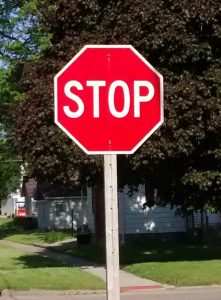InTrans / Dec 14, 2016
Iowa LTAP study puts together impacts of traffic signs in one publication

The safety and operational impacts of traffic signs can now be found in one publication recently produced by the Iowa Local Technical Assistance Program (LTAP) located at Iowa State University’s Institute for Transportation.
The Sign Effectiveness Guide is a compilation and critical review of 48 research documents focusing on potential impacts of 11 static or enhanced signs commonly used by local jurisdictions.
David Veneziano, LTAP safety circuit rider, and Keith Knapp, Iowa LTAP director, led the research. They said transportation professionals can use the guide, along with the MUTCD (Manual on Uniform Traffic Control Devices), to better understand whether a particular sign can be expected to impact safety or operations.
It also can help agencies to better manage their signing budgets.
“Signing represents a significant investment for all government agencies,” Veneziano said, “and it has become even more significant with the requirement to implement an assessment and management plan for the maintenance of minimum sign retroreflectivity.”
The researchers collected and reviewed information on sign effectiveness, including the purpose of each sign; relevant information from the MUTCD; potential safety, operational, and behavioral impacts identified by past research; and alternatives to signage, such as increased enforcement or pavement markings.
Some of the signs studied in the research were Stop, Yield, Speed Limit, Playground, Children at Play, Ice Warning, Deer Crossing, and enhanced signs, such as a Stop sign equipped with a flashing beacon. The researchers also looked at some warning systems, including Prepare To Stop When Flashing signs and horizontal alignment signs, such as curve warning, chevrons, and advisory speed plaques.
They assigned reliability ratings of Low, Medium, or High to the research results, focusing on the potential safety or operational impacts of the signs and warning systems. Thirty-three of the results were rated Medium or High.
Veneziano and Knapp learned that few studies of the safety and operational impacts of basic traffic signs exist even though traffic signs are everywhere along America’s roadways. “That’s why it was important for us to rate the research projects,” Veneziano said. He explained that their research gives a sense of the how reliable each study was, based on factors such as sample size, site diversity, and statistical analysis approach.”
Results of many existing studies are good, Veneziano said, yet traffic professionals must be cautious how they apply them. “Research results from a study in a rural area may not be applicable in an urban area.”
Knapp said the lack of documented research on a sign’s safety or operational effectiveness does not mean it is ineffective. “Many static and enhanced signs are currently being studied, and it is expected that many more will be, particularly with the relatively new driver behavior databases being created.”
Veneziano said that in addition to their safety and operational effects, signs produce other driver behavioral changes and impacts that are not as easy to measure.
“These could be changes in decision-making, acknowledgment of the additional and expected notification of a hazard, and general increase or heightened awareness of a specific regulation or hazard. They are all essential to the safety and operations of the transportation system.”
The Iowa Highway Research Board and the Iowa Department of Transportation funded the study.